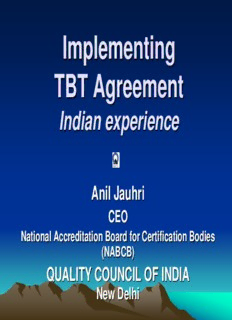
Mr. Anil Jauhri - Centre for WTO Studies PDF
Preview Mr. Anil Jauhri - Centre for WTO Studies
Implementing TBT Agreement Indian experience Anil Jauhri CEO National Accreditation Board for Certification Bodies (NABCB) QUALITY COUNCIL OF INDIA New Delhi TBT Agreement – Salient features • Encourage adoption of Intl Stds – not deemed to be barriers - Increased relevance of International Standards in trade –both for products as well as systems • Freedom to prescribe Mandatory Standards from standpoint of National security, Prevention of deceptive practices, Health, Safety & Environment • Legislative framework • National treatment – Same standards for domestic and overseas Industry • MFN Principle – Standards to be applied equally to all countries COMMON FEATURES (contd) • Transparency –Opportunity to Comment to Interested Parties; procedures and systems to be public • Mutual Recognition of Conformity Assessment – Certification/ Inspection/ Test Reports - Provision for recognition of export control & certification systems of trading partners as equivalent - Accreditation of labs/inspection/ certification bodies IMPLICATIONS • Relevance of international standards – pressure on India to adopt – from foreign goods coming in, NGOs, for export, international funding agencies - effective participation vital • Every international standard is potential instrument for international trade • Two regimes - Regulatory & Voluntary • Applicable to both domestic and international markets • Regulatory regime - from standpoint of health, safety, environment • Sectors –electrical appliances, toys, gas appliances, safety equipment, drugs, electronics/IT/telecom goods, textiles – children wear, medical devices, lead in paints IMPLICATIONS (CONTD) • Compulsory BIS certification (Cement, Electrical appliances etc), Drugs Act, FSSA, Mines Act • Conformance to International/importing countries’ technical regulations for access to overseas markets • Countries implementing strong import controls (USA, EC, Canada, Australia, New Zealand, Japan) – product, EC regulations for energy using products requiring LCA • Technical barriers - regulations IMPLICATIONS (CONTD) • Voluntary regime - insistence on ISO 9000, ISO 14000- generally by organized buyers- initially in foreign countries-increasingly in India – RDSO for vendors – ISO 9000 certification from NABCB accredited CBs • Company or buyers’ specifications for vendors/suppliers– both product and systems - examples Ford, General Motors, Maruti • Pressure from international funding agencies like World Bank – example ISO 14000 in NTPC • Even in regulatory sectors – food – US/Europe - GlobalGap • Becoming barriers – not discussed by govts • Industry to gear up for both EMERGING STRUCTURE Government (to enact legislation) Regulatory Bodies – may be sector specific like Food, Drugs (to enforce the law) National Standards Body – Accreditation Body (vol. standards-linkage to RBs) - (tech.competence of CABs) Conformity Assessment Bodies (CABs) (support regulation – voluntary certification/quality assurance) Manufacturers and Service providers Common man – recipient of goods and services INFRASTRUCTURAL REQUIREMENTS • Nodal point for participation in international stdzn (Codex/ISO/IEC/ITU)-Min of Health/BIS/DoT • Domestic Regulatory Mechanism (BIS Act/Drugs/PFA/Food Law) • Export regulation & certification system (EIC) for recognition • Information access (TBT/SPS enquiry points – BIS/Min of Agriculture/Health) • Accreditation Mechanism (NABCB/NABL) • Conformity assessment bodies (BIS/EIAs/Govt & Pvt certification/inspection bodies/labs) ISSUES FACING INDIA • Underregulated – sectors still not having regulations – free entry to foreign goods • Lack of suitable legal instrument – no Act to empower govt to notify regulations across sectors, freedom to prescribe conformity assessment procedure • Need to upgrade domestic regulation – international standards, conformity assessment – certification/inspection/ testing as per international standards – accreditation – Differential standards ISSUES FACING INDIA • EC regulation on accreditation wef 1 Jan 2010 – use of accreditation by regulators • Response to importing countries’ regulations – neither comments nor preparation – herbal medicines, EUTR for wooden exports (handicrafts) • Use of voluntary international recognition arrangements like in accreditation – IAF/ILAC MRAs – IECEE CB scheme - acceptance within and then by importing countries
Description: